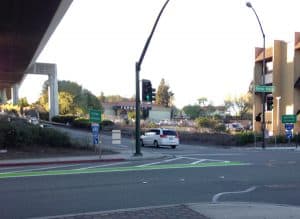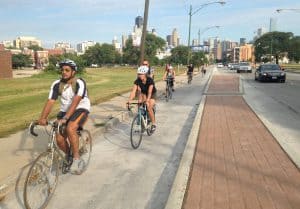 Green bike lanes have landed in Walnut Creek just in time for Bike to Work Day! The bike lane on Olympic Blvd has been painted green on the segment between N. California and the I-680 on ramp.
Green bike lanes have landed in Walnut Creek just in time for Bike to Work Day! The bike lane on Olympic Blvd has been painted green on the segment between N. California and the I-680 on ramp.
 The creation of green bike lanes has been on the rise in the Bay Area since San Francisco’s first green lanes on Fell Street in 2010. It’s an inexpensive way to remind motorists to stay alert for cyclists, especially when drivers have to enter the green-painted area to change lanes or make a turn.
The creation of green bike lanes has been on the rise in the Bay Area since San Francisco’s first green lanes on Fell Street in 2010. It’s an inexpensive way to remind motorists to stay alert for cyclists, especially when drivers have to enter the green-painted area to change lanes or make a turn.
Does the painting of bike lanes help? A report on Portland’s painted bike lanes concluded:
The percentage of motorists yielding increased to 92 percent, a 27 percent increase… The overwhelming majority [of cyclists] (76 percent) felt that the locations were safer since the installation.
 Given the benefits of painted bike lanes, it’s no surprise that at least 7 of the projects that made People for Bikes‘ list of the Best New Bike Lanes feature green paint.
Given the benefits of painted bike lanes, it’s no surprise that at least 7 of the projects that made People for Bikes‘ list of the Best New Bike Lanes feature green paint.
If you want to see what the future of bike lanes might look like (or just drool over some amazing bike infrastructure), check out People for Bikes’ America’s 10 Best New Bike Lanes of 2015.
